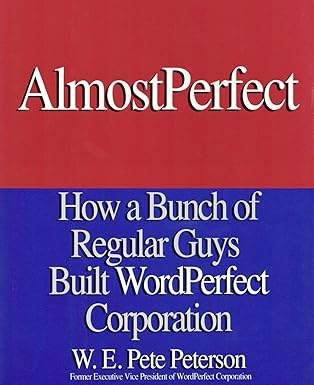Almost Perfect
url: http://www.wordplace.com/ap/  ISBN: 978-0788199912
ISBN: 978-0788199912
This review is written in markdown in WordPerfect 8 within a Linux terminal. This is not taking place due to a sense of nostalgia so much as it is appropriate to the review in focus.
Many of us, including the reviewer, have used WordPerfect at one point or another. Markdown, is, in many ways, the answer to what was lost when Microsoft Word began to replace WordPerfect. WordPerfect has something that modern word processors lack–a user can push a button marked “Reveal Codes” and once this is done begin to understand what “hidden formatting” is present in the document that might be causing formatting issues.
The book “Almost Perfect,” by W.E. Pete Peterson, tells the tale of how WordPerfect rose and eventually fell on its own sword. What makes the tale especially interesting is that it traces the narrative through a time when business was just beginning to migrate from traditional goods, in Peterson’s case, a family-owned drapery business, to ‘adoptive families’ via technology companies. The old models of making money were beginning to become difficult to maintain, and the new models were in the digital frontiers and had better profit margins.
Peterson, though, tries to maintain what he considers to be a “fair” balance between running the company, and having friends while earning outrageous amounts of profit. He was, quite literally, following his dreams and would eventually have more than enough money to gather if only he had enough hands to help him gain it.
Within the company, the predictable story of the original founders, not really understanding what they are doing and quickly discovering an entire world of money and logistics and personality conflicts, comes into view and to deal with this issue Peterson builds a scaffolding that proves to be his legal undoing later when the company decides it wants to remove him to head into some “new direction.” Peterson, instead of being viewed as a conservative is relegated to being a wet-blanket, and the company no longer wants him there. They hire him on as a consultant, but he later deduces they do not want his information, only his silence. It is a hard blow to Peterson, who feels guilty in the work for leaving his family for extended times. He even states, at one point, that the technology business became like a drug of which he could not get enough. As his focus begins to shift to his family in the work, his removal seems to be not far behind.
Between times, he is working hard to fend off Microsoft that has an inferior product. (and still does to this day) Microsoft eventually, however, breaks into the GUI market and begins its steady assent to where it is today. (the beginning of its twilight years)
There are many stops along the way, and the management style that Peterson suggests is the best, even with all of the problems concomitant with its application he experiences, is to allow employees to govern themselves, and to learn to subdivide job responsibilities quickly and effectively as the organization grows.
The book is a great read for anyone that wants to understand the early technology field and what the decisions looked like that formed the terrain we are experiencing today. Indeed, the 2020 US elections concerned much by way of technology and how its use influenced the outcome. Peterson lets us know that the competition even in the early time was brutal and is himself a decidedly rich casualty. Since you can read the book for free, there is nothing preventing you from doing so except taking the time to do it.